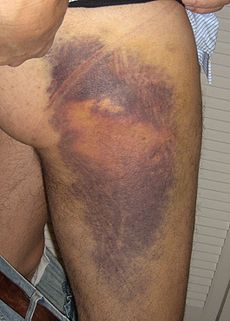- Hematoma
-
Hematoma Classification and external resources 
Hematoma on thigh, 6 days after a fall down stairs, 980 ml of blood drained a few days laterICD-10 T14.0 DiseasesDB 5487 MeSH D006406 A hematoma, or haematoma, is a localized collection of blood outside the blood vessels,[1] usually in liquid form within the tissue. This distinguishes it from an ecchymosis, which is the spread of blood under the skin in a thin layer, commonly called a bruise. Internal bleeding is generally considered to be a spreading of blood within the abdomen or skull, not within muscle.
It is not to be confused with hemangioma which is an abnormal build up of blood vessels in the skin or internal organs.
Contents
Presentation
The word "hematoma" came into usage around 1850. The word derives from the Greek roots "hemat-" (blood) and -oma, from soma, meaning body = a body of blood. Another etymological derivation would be from "haemat-" and "-oma" = "-ing", thus simply "bleeding".
Hematomas can occur within a muscle. Some hematomas form into hard masses under the surface of the skin. This is caused by the limitation of the blood to a subcutaneous or intramuscular tissue space isolated by fascial planes. This is a key anatomical feature that prevents such injuries from causing massive blood loss. In most cases the sac of blood or hematoma eventually dissolves; however, in some cases they may continue to grow or show no change. If the sac of blood does not disappear, then it may need to be surgically removed. Hematomas can occur when heparin is given via an intramuscular route; to avoid this, heparin must be given intravenously or subcutaneously.
The slow process of reabsorption of hematomas can allow the broken down blood cells and hemoglobin pigment to move in the connective tissue. For example, a patient who injures the base of his thumb might cause a hematoma, which will slowly move all through the finger within a week. Gravity is the main determinant of this process.
Hematomas on articulations can reduce mobility of a member and present roughly the same symptoms as a fracture.
Classification
Types
- Subdermal hematoma (under the skin)
- Head/brain:
- Subgaleal hematoma – between the galea aponeurosis and periosteum
- Cephalohematoma – between the periosteum and skull. Commonly caused by vacuum delivery and vertex delivery.
- Epidural hematoma – between the skull and dura mater
- Subdural hematoma – between the dura mater and arachnoid mater
- Subarachnoid hematoma – between the arachnoid mater and pia mater (the subarachnoid space)
- Othematoma – between the skin and the layers of cartilage of the ear
Degrees
- Petechiae – small pinpoint hematomas less than 3 mm in diameter
- Purpura (purple) – a bruise about 1 cm in diameter, generally round in shape
- Ecchymosis – subcutaneous extravasation of blood in a thin layer under the skin, ie bruising or "black and blue".
References
- Notes
Foreign body In alimentary tract (Bezoar)Other By region Pathology: hemodynamics Decreases general: Anemic infarct · Hemorrhagic infarct
regional: Myocardial infarction · Cerebral infarction · Splenic infarction · Limb infarctionIncreases general Bruise/Hematoma: Petechia · Purpura · Ecchymosis
regional: head (Epistaxis, Hemoptysis, Intracranial hemorrhage, Hyphema, Subconjunctival hemorrhage) · torso (Hemothorax, Hemopericardium, Pulmonary hematoma) · abdomen (Gastrointestinal bleeding, Haemobilia, Hemoperitoneum, Hematocele, Hematosalpinx ) · joint (Hemarthrosis)general: Anasarca · Angioedema/Lymphedema · Exudate/Transudate
regional: Cerebral edema · Pulmonary edema · Hydrothorax · Ascites/hydroperitoneum · HydrosalpinxOtherCategories:- Pathology stubs
- Gross pathology
Wikimedia Foundation. 2010.
